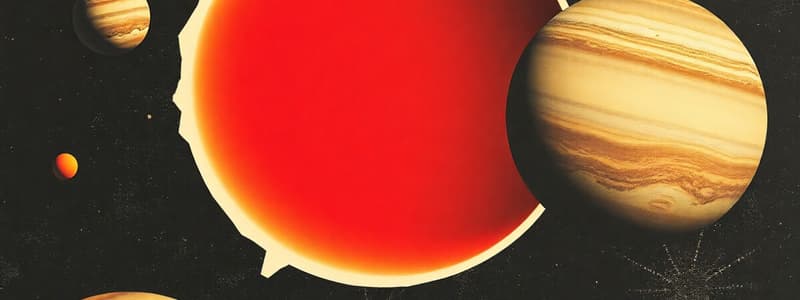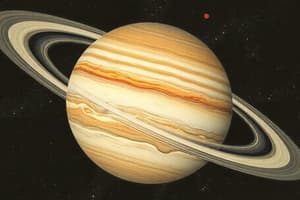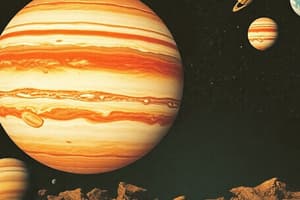Podcast
Questions and Answers
If a person weighs 100 pounds on Earth, approximately how much would they weigh on Jupiter?
If a person weighs 100 pounds on Earth, approximately how much would they weigh on Jupiter?
- 100 pounds
- 240 pounds (correct)
- 1,300 pounds
- 43 pounds
Which of Jupiter's moons is known for its volcanic activity and sulfur-rich surface?
Which of Jupiter's moons is known for its volcanic activity and sulfur-rich surface?
- Ganymede
- Callisto
- Europa
- Io (correct)
What is the primary mission of the Europa Clipper?
What is the primary mission of the Europa Clipper?
- To photograph the Great Red Spot from a closer proximity
- To measure the strength of Jupiter's magnetic field
- To study Jupiter's ring system in detail
- To determine if there are places that could support life below the surface of Europa (correct)
Which of Jupiter's rings is closest to the planet?
Which of Jupiter's rings is closest to the planet?
If Pioneer 10 sent its last signal in January 2003, and was launched in March 1972, approximately how long was it transmitting data?
If Pioneer 10 sent its last signal in January 2003, and was launched in March 1972, approximately how long was it transmitting data?
Which of the following NASA spacecraft was deliberately destroyed in Jupiter's atmosphere to protect one of its discoveries?
Which of the following NASA spacecraft was deliberately destroyed in Jupiter's atmosphere to protect one of its discoveries?
Why is Jupiter named after a Roman god?
Why is Jupiter named after a Roman god?
What is the Great Red Spot on Jupiter?
What is the Great Red Spot on Jupiter?
What is the approximate length of a day on Jupiter?
What is the approximate length of a day on Jupiter?
Which statement accurately describes the composition of Jupiter's atmosphere?
Which statement accurately describes the composition of Jupiter's atmosphere?
Which of Jupiter's moons is thought to potentially harbor twice as much water as Earth?
Which of Jupiter's moons is thought to potentially harbor twice as much water as Earth?
What is the main purpose of the Juno mission to Jupiter?
What is the main purpose of the Juno mission to Jupiter?
What discovery was made by Voyager 1 during its Jupiter flyby in 1979?
What discovery was made by Voyager 1 during its Jupiter flyby in 1979?
How long does it take for sunlight to reach Jupiter from the Sun?
How long does it take for sunlight to reach Jupiter from the Sun?
What distinguishes Jupiter's rings from Saturn's rings?
What distinguishes Jupiter's rings from Saturn's rings?
Approximately how many Earths could fit inside Jupiter?
Approximately how many Earths could fit inside Jupiter?
Which spacecraft used Jupiter's gravity to assist it in reaching its ultimate destination, Saturn?
Which spacecraft used Jupiter's gravity to assist it in reaching its ultimate destination, Saturn?
Which moon is the largest moon in the solar system and also larger than the planets Mercury and Pluto?
Which moon is the largest moon in the solar system and also larger than the planets Mercury and Pluto?
Which spacecraft is scheduled to continue investigating Jupiter through September 2025?
Which spacecraft is scheduled to continue investigating Jupiter through September 2025?
Flashcards
What is Jupiter?
What is Jupiter?
Jupiter is a gas giant and the fifth planet from the Sun, known for its Great Red Spot and strong winds.
What is the Great Red Spot?
What is the Great Red Spot?
A centuries-old storm on Jupiter, larger than Earth, with winds exceeding 400 mph.
What is Jupiter's Halo ring?
What is Jupiter's Halo ring?
A faint, wide doughnut-shaped ring that is closest to Jupiter.
What is Jupiter's Main ring?
What is Jupiter's Main ring?
Signup and view all the flashcards
What are Jupiter's Gossamer rings?
What are Jupiter's Gossamer rings?
Signup and view all the flashcards
How long is a day on Jupiter?
How long is a day on Jupiter?
Signup and view all the flashcards
How long is a year on Jupiter?
How long is a year on Jupiter?
Signup and view all the flashcards
What is Ganymede?
What is Ganymede?
Signup and view all the flashcards
What is Callisto?
What is Callisto?
Signup and view all the flashcards
What is Io?
What is Io?
Signup and view all the flashcards
What is Europa?
What is Europa?
Signup and view all the flashcards
What is Pioneer 10?
What is Pioneer 10?
Signup and view all the flashcards
What did Voyager 1 discover?
What did Voyager 1 discover?
Signup and view all the flashcards
What is Voyager 2 known for?
What is Voyager 2 known for?
Signup and view all the flashcards
What did the Galileo spacecraft do?
What did the Galileo spacecraft do?
Signup and view all the flashcards
What was Cassini's mission?
What was Cassini's mission?
Signup and view all the flashcards
What is the goal of the Juno mission?
What is the goal of the Juno mission?
Signup and view all the flashcards
What is the goal of the Europa Clipper mission?
What is the goal of the Europa Clipper mission?
Signup and view all the flashcards
Study Notes
Overview of Jupiter
- Jupiter is a gas giant and the fifth planet from the Sun.
- It is so large that more than 1,300 Earths could fit inside.
- Named after the king of the ancient Roman gods.
- Its atmosphere consists mainly of hydrogen and helium, similarly to the sun.
- The atmosphere is very thick, covered in thick red, brown, yellow, and white clouds that give the planet a striped appearance.
- Sunlight needs 43 minutes to reach Jupiter from the Sun.
The Great Red Spot and Weather
- Jupiter's Great Red Spot, a storm larger than Earth, has lasted for centuries.
- Winds on Jupiter exceed 400 mph, surpassing hurricane and tornado speeds.
- About 3 1/2 Earths could fit across the Great Red Spot.
Jupiter's Rings
- Jupiter possesses three thin rings, unlike Saturn's prominent ones.
- These rings, mainly composed of tiny dust particles, were discovered in 1979 by NASA’s Voyager 1.
- The rings include:
- Halo: A faint, wide, doughnut-shaped ring closest to Jupiter.
- Main Ring: Extends from the halo ring, with the moons Adrastea and Metis orbiting within it, believed to be dust sources for the ring.
- Gossamer Rings: Extremely faint rings made of microscopic debris from Amalthea and Thebe, extending beyond Amalthea's orbit.
Rotation and Orbit
- Jupiter has the fastest rotation of any planet, completing a spin in approximately 10 hours.
- It takes Jupiter 12 Earth years to orbit the Sun, making a year on Jupiter equivalent to 12 Earth years.
Gravity and Temperature
- Jupiter experiences very cold temperatures.
- Higher gravity compared to Earth, a 100-pound person would weigh about 240 pounds on Jupiter.
Jupiter's Major Moons
- Jupiter has four main moons: Ganymede, Callisto, Io, and Europa.
- Ganymede: The largest moon in the solar system, it surpasses both Mercury and Pluto in size.
- Callisto: Characterized by a heavily cratered surface.
- Io: Notable for its numerous volcanoes that emit gases rich in sulfur, giving its surface a yellow-orange color from sulfur deposits.
- Europa: Covered with water ice, possibly concealing a subsurface ocean with twice the water volume of Earth.
Jupiter's Exploration by NASA
- NASA has explored Jupiter using ground-based telescopes, the Hubble Space Telescope, and various spacecraft missions.
- Pioneer 10: Launched in March 1972, reached Jupiter in December 1973, and transmitted its last signal in January 2003 from 7.6 billion miles away.
- Pioneer 11: Flew closer to Jupiter in 1974 en route to Saturn.
- Voyager 1: Discovered a thin ring, two new moons (Thebe and Metis), and active volcanoes on Io during its flyby in March 1979.
- Voyager 2: The only spacecraft to study all four giant planets and discovered Jupiter's 14th moon. Explored the region outside the heliopause.
- Galileo: The first spacecraft to orbit an outer planet, studied Jupiter and its moons for eight years. It was deliberately destroyed in Jupiter's atmosphere in 2003 to protect Europa's possible subsurface ocean.
- Cassini: Studied the Jupiter system for six months (October 2000 - March 2001) to use Jupiter's gravity to slingshot towards Saturn.
- Juno: Launched in 2011 and arrived at Jupiter in 2016 to study the planet's origin, evolution, and planet formation processes. Scheduled to continue investigations through September 2025. Named after the Roman goddess Juno, who could see through Jupiter's deceptive clouds.
- Europa Clipper: Launched in October 2024, expected to reach Jupiter in 2030 to investigate Europa for potential life-supporting conditions.
Studying That Suits You
Use AI to generate personalized quizzes and flashcards to suit your learning preferences.



